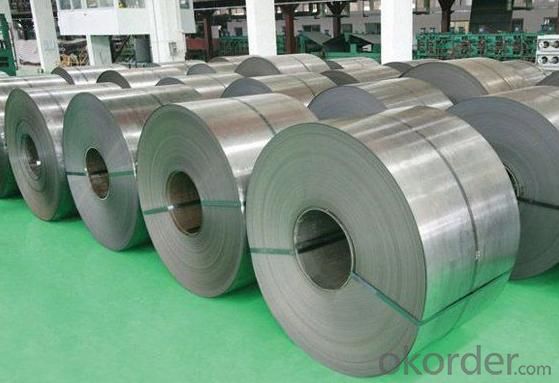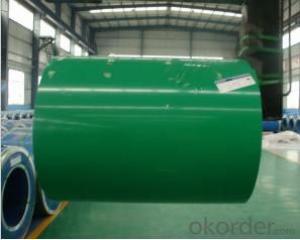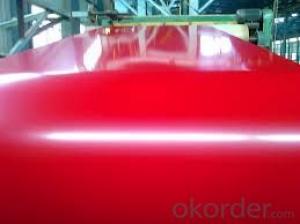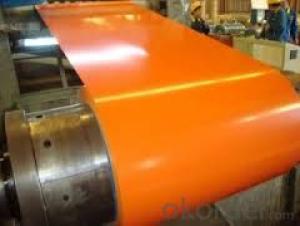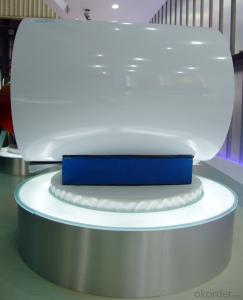PPGI Prepainted Galvanized Steel Coil/Roofing Steel
- Loading Port:
- Shanghai
- Payment Terms:
- TT OR LC
- Min Order Qty:
- 50 m.t.
- Supply Capability:
- 8000 m.t./month
OKorder Service Pledge
OKorder Financial Service
You Might Also Like
PPGI Prepainted Galvanized Steel Coil/Roofing Steel :
| Standard: | AISI,ASTM,BS,DIN,GB,JIS | Grade: | SGCC | Thickness: | 0.18mm-1.2mm |
| Place of Origin: | China (Mainland) | Brand Name: | CNBM | Type: | Steel Coil |
| Technique: | Hot Rolled | Surface Treatment: | Galvanized | Application: | building material |
| Special Use: | High-strength Steel Plate | Width: | 914mm-1250mm | Length: | as per customer |
| color: | ral k7 |
Packaging & Delivery
| Packaging Detail: | seaworthy export package 3 eye bands and 3 circumferential bands in steel, galvanized metal fluted rings on inner and outer edges, galvanized metal & waterproof paper wall protection disk, galvanized metal & waterproof paper around circumference. |
| Delivery Detail: | 15 Days after advance payment |
Name | PPGI |
Raw material | SGCC |
Thickness | 0.18mm-1.2mm |
Width | 914mm-1250mm |
Tolerance | Thickness+/-0.01mm |
Surface treatment | Galvanized |
T bending (top-coating) T bending (back-coating) | 3T 4T |
Anti-MEK wiping | ≥100times |
Zinc coating | 40-100g |
Painting thickness: top back | 15-16u 6-7u |
Type of coating structure | 2/1 |
standard | ASTM,GB,JIS |
Coil weight | 3ton-5ton |
Coil ID | 508 |
Color | RAL (customized) |
Applications | Building industry, structural use, roofing, commercial use, household appliance, industry facilities |
Attentions in transportation and storage :
1:PPGI should be stored in neat and tidy environment to avoid possible corrosion caused by all kinds of corrasive medium.
2:The ground for storage should be flat, without hard object, and with sufficient loading-bearing capacity.
3:Storage environment should be dry and ventilated. Avoiding storing outdoors or with dew or with wide temp difference.
4:Coil could not be dragged lest the burr caused by slicing will scratch the coil surface underneath. Coil should be handled with care, without hitting any hard objects.
- Q: I had heard of steel braided fuel lines but ive also seen some air and coolant lines that are steel braided. Are these commonly used? I guess what I'm asking is if its a good idea to use them.
- Very good idea depending on the application. The steel braid reinforces the rubber to make it withstands pressure. Example, pressure side of power steering pump is reinforced, the return side doesn't usually need to be. Carbed cars usually run around 3-7 lbs on fuel line so no need, fuel injected cars run roughly 45 psi and up usually so those are braided.
- Q: What are the different types of steel finishes available for coils?
- There are several types of steel finishes available for coils, including hot-dip galvanized, galvannealed, electro-galvanized, and painted finishes.
- Q: How are steel coils used in the manufacturing of industrial machinery?
- Steel coils are used in the manufacturing of industrial machinery as they serve as the primary raw material for various components such as frames, casings, gears, and structural supports. These coils are typically cut, shaped, and welded to create the desired machine parts, ensuring strength, durability, and precision in the final product.
- Q: could someone please explain to me in detail the functions of stainless steel wall ties?
- wall ties are used to tie brick coursing to the back up wall...stainless steel will simply last longer than the others but you will pay dearly for them...
- Q: I was wondering because i just watched an episode of build it bigger on the discovery channel about the uss George bush, and when they were discribing it they said it was 500 tons of steel and 47,000 tons of aluminum. this kinda struck me as odd because i thought that it was mostly made of steel. and i would think that even if it was mostly aluminum, that the hull would be steel. and i think the hull would weigh more than 500 tons.
- STEEL okorder /
- Q: I moved into a house which has a steel front door.When I touch the door it feels very cold to the touch in the winter.There is a storm door also and the weather stripping looks good.Cold air from the door is entering the lower level.The house is about 20 yrs old.
- Steel doors are insulated,but will feel cold in the winter.Feel all around the door weather stripping area and the seal at the bottom of the door to see if air is getting in.
- Q: Is it possible that stainless steel watches get rust. Any experience? Thanks.
- Stainless Steel comes in many different grades, a prime example is to see if a magnet sticks to it if so it has a high iron content as the grade of the stainless increases its magnetic ,iron properties decrease have you ever left a stainless knife, fork, spoon in a kitchen sink for a few days it will show evidence of rusting most jewelery is low grade stainless as it does not need to to be suitable for medical grade or marine grade quality under normal conditions wearing your stainless steel watch will not make it rust however if you were to leave that watch in contact with another metal and they are wet then yes it will rust as it will create a chemical reaction.
- Q: Can steel coils be customized according to specific requirements?
- Yes, steel coils can be customized according to specific requirements. Manufacturers can tailor the dimensions, thickness, width, and coating of steel coils to meet the specific needs of their customers. This customization allows for greater flexibility and ensures that the steel coils are suitable for various applications and industries.
- Q: How are steel coils used in the manufacturing of pressure vessels?
- Steel coils are used in the manufacturing of pressure vessels as they are processed into flat sheets and then formed into the desired shape. These coils provide strength and durability to the pressure vessel, ensuring it can withstand high pressures and temperatures.
- Q: How are steel coils used in the manufacturing of construction bulldozers?
- Steel coils are used in the manufacturing of construction bulldozers to create the main structural components, such as the chassis and the blade, which require the strength and durability that steel provides. The coils are processed and shaped into the desired parts through cutting, bending, and welding techniques, ensuring the bulldozers can withstand heavy loads and harsh working conditions on construction sites.
Send your message to us
PPGI Prepainted Galvanized Steel Coil/Roofing Steel
- Loading Port:
- Shanghai
- Payment Terms:
- TT OR LC
- Min Order Qty:
- 50 m.t.
- Supply Capability:
- 8000 m.t./month
OKorder Service Pledge
OKorder Financial Service
Similar products
Hot products
Hot Searches
Related keywords


